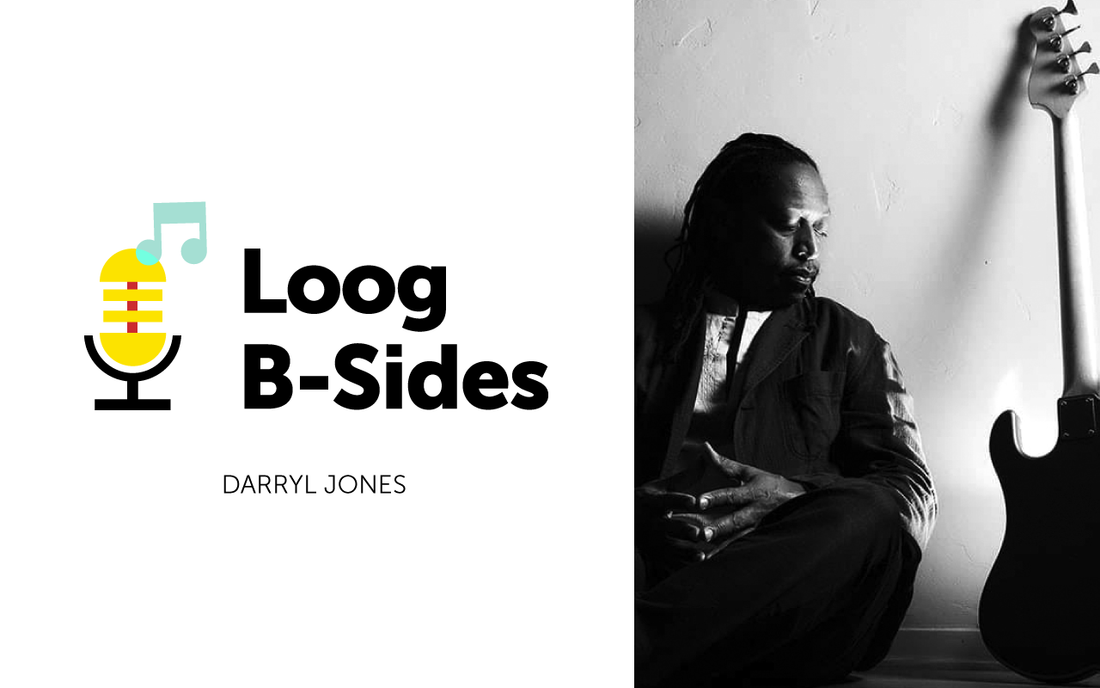
Loog B-Sides: The Musical Childhood of Darryl Jones
This is the fourth episode of Loog B-Sides, a series of conversations that celebrates and shines a spotlight on some of our fave Loog Community members. You can also listen to excerpts from this feature and others from Loog B-Sides on Spotify.
How does someone become a great rockstar? When did it all start? And what’s the best way to keep that spark and growing love for music alive? Based on Darryl Jones’ personal history, the answer might just be following your kids’ musical whims, variety and, of course, a little luck.
Darryl Jones is arguably one of the best bass guitar players in the world. He started his career with the one and only Miles Davies, and has been recording and touring with The Rolling Stones since 1993 (playing with Peter Gabriel and Sting in the middle). He also designs his own line of basses and guitars, under his very own Jones Musical Instruments brand.

We sat down a while ago with Darryl Jones to better get to know him, his beginnings, how he became the rockstar he is and how he discovered music during his childhood. This is what he had to say.
Don’t feel like reading? You can also listen to an excerpt of Darryl’s interview on Spotify.
When did you first start playing bass?
I kind of grew up in a musical household. Both my mother and father, music lovers. My father actually was the first to teach me how to read music basically because he played drums a little bit when he was in the service and when he was young, I always practiced with a little practice pad. So I started on that when I was about 7 years old. It was after I saw a friend, a neighborhood friend (the guy who lived a couple of doors down) play in the elementary school talent show that I decided I want to learn how to play the guitar. I didn't really know the difference between the bass and the guitar at that time. I just saw him playing the guitar and decided to ask him to teach me to play. And so when I asked him, I said: “Can you teach me how to play the guitar?” And he said, “You want to learn how to play the lead guitar or the bass guitar?” And I said, “Well, what do you play?” And he said, “Well, I play the bass.” So I said, “Well, I want to learn how to play the bass.” That's actually how I got to be a bass player.
What music did your parents listen to around you?
My father was a big jazz fan. So I had been hearing jazz music my entire life and was aware of it. And of course, he encouraged me to get involved with learning to play jazz music. The guy who taught me - a guy named Angus Thomas, we're still great friends - he taught me songs from many different genres. The first song was ‘Thank You (Falettinme Be Mice Elf Agin)’ by Sly & The Family Stone. It wasn't the version that Larry Graham played, but it was a simpler version. But that, Led Zeppelin, The Staple Singers, ‘The Cisco Kid’ by War, the band War. And so I was really learning a lot of different kinds of music from the beginning. Of course, my mother loved Motown and James Brown. So, all of those became influences and I was one of the really lucky musicians to learn all of the different genres of music, or many different genres of music, kind of from the beginning.

How important was learning music in your life, growing up?
I think it's very important that children learn music. I think it helps with all walks of life, for children to be involved in music.
I went to a really great high school, with a good music education program. I went away to college for a year outside of Chicago and studied music, played with a lot of different bands. Didn't do as much schoolwork as I should have, but, you know, in high school and in that year of college, I got a lot of really great music education.
How did you end up playing with Miles Davis?
I came back to Chicago after a year and started playing around the Chicago music scene. And one of the musicians that I played a lot with was Vincent Wilburn Jr., a drummer, who was also Miles’ nephew. And so obviously we talked about his connection to Miles and at one point he recorded ‘Man with a Horn’ with Miles. And of course, when he came back, we were all asking him, what was it like to play the notes and to record with Miles.
A few years later he went on tour with Miles, I think it was in Japan - pretty sure it was in Japan. And at the end of that tour Miles decided to make a change to the bass player. And Vincent recommended me. Miles asked him, “Are there any guys in Chicago that I should hear?” And Vince told him, “Yeah, you should hear Darryl.” So they called me on the phone and he tells me over the phone. He says, “Miles wants to hear you play over the phone.” And I thought, whoa! You know, at first I thought he was joking, but it ended up that he wasn't joking.

But I never did end up playing over the phone with Miles. I ended up flying to New York the next day and I played. Yeah, it was great. And I got a chance to meet Miles Davis. It was great. And I auditioned for him and he hired me. So that was a very special, really special. I feel really incredibly blessed to have had that experience so early in my career. And it changed everything.
My traveling began with Miles. We traveled all over Europe, all over Japan. I never went to South America with Miles, but, of course, with Sting we also had a world tour where we went everywhere.
When did you first start playing for The Rolling Stones?
A friend of mine called me and told me, he said, “Listen, man, I think I heard that Bill Wyman is leaving the Stones”. And I thought, “Well, man, of course, we've been hearing those rumors for years.” And he said, “no, he’s leaving this time.” And he said, “Should I try to find a phone number for Mick Jagger's management or something?”
I ended up going to New York in May of 1993 to audition with the Stones, and played through a lot of the hits: ´Honky, Tonk’ and ‘Brown Sugar’ and a bunch of the well-known songs. And a few months later, I went back to audition with them again, after they had written the music for ‘Voodoo Lounge’, which was the first record that I played on.
And it was then that they hired me to record that record. And during the recording of that record, they also asked me to come on and go on tour with them.
What’s recording with The Rolling Stones like?
We just try things. We do a few takes and track a few different things, sit around and talk. We'll listen and Mick or Keith will say, “Well, let's try this.” Or somebody will come up with an idea and we try that and just keep knocking at it until you come up with something that feels right. I think that's part of the charm of it, it’s just kind of off the cuff, which rock and roll should be. It shouldn't be too well thought-out, you know, it should be a little bit loose.
You can listen to an extract of Darryl’s interview on Spotify.
